|
From
1910 onward Smith and Wesson Hand Ejector revolvers came
in target variations equipped with adjustable sights.
Rimfire revolvers built on the .32 frame were considered
heavyweights and the first serious effort toward a .22 built on
the 38 (K) frame did not come about until 1931.
The high velocity .22 long rifle cartridge had become
popular and the company advertised the new K-22
“Outdoorsman” as being specifically designed for the high
speed round.
It
was marketed to hunters and outdoorsmen in a climate that could
not have been less ideal. The
Great Depression was in full swing and there was a serious
effort to include handguns in the prohibitive tax and
registration structure of the Federal Firearms act of 1932 and
34. Nevertheless
the K 22 was an immediate success with well-heeled sportsmen as
well as police and military training programs.
Supica
–Standard
Catalog of Smith and Wesson records that an Army
team took several K 22s to the 1932 Olympics providing an early
launch into the mainstream target circuit.
By 1940, shooters or agencies had bought 19,500 of the
first model and a second model was in the catalogues as “A
replica of that favorite, the .38 M&P Target Revolver” (Stoeger-Shooter’s
Bible). By
this time, it had become the K 22 ‘Masterpiece’ and was
firmly identified with organized target shooting.
Wartime rationing stopped production in 1941 with
something over 1,000 units of the second models out the door.
Post-War
production resumed in 1946 with the K-22 becoming part of a
target set including the K-38 and the redesigned, Post-War K-32.
The revolver assumed the profile that would define the Smith
Hand Ejectors until 1989. Variations
abound and generally follow the evolution of the Smith Hand
Ejectors as a family. The
defining theme of the K 22 target revolvers and the current 617s
is the intent of their purchasers to have the best of all
possible rimfire revolvers.
There
is a long- standing tradition that regards each model variation
as a poor imitation of its immediate predecessor. In the case of
the K-22, this occurred each time the side plate or frame shed
another screw, in 1957 when the model names gave way to the
number system and in the late 20th Century when the
classic ribbed barrels disappeared in favor of the heavy
under-lugs. Throughout history, it has been just possible to
acquire a substandard K-22 and there have been periods when
workmanship really suffered.
There were legitimate complaints about quality control
during the Vietnam War Era. In
the ‘70s, many revolvers felt like a handful of gravel had
been trapped under the side plate. In the main though, the K-22
by any name and from any decade, provides its own justification
for pride of ownership.
Optimum
Accuracy
Post
World War II, the factory promised that each K Series target
revolver would group five rounds inside of 1.5” at 50 yards.
My heavy lugged 617-3 from 1999 will demonstrate this
level of accuracy with a good selection of premium small game
and varmint loads. Mounted
with its Weaver 1.5-4x LER Variable, it regularly
produces sub one inch accuracy at 25 yards and will deliver CCI
Mini-Mags, Velocitors, Stinger, Aquilla QuikShok and Remington
Golden Bullet Hollow Point into the magic 1.5” at 50.
My. 1947 K-22 and the Model 17-5 from 1988 are not a bit
ammunition sensitive and regularly produce .9” to 1.1”
groups at 25 yards with the same list of ammunition.
Experience tells me that the scoped gun will shoot closer
than I can hold. I
have also learned that my iron sight groups are forty to fifty
percent larger than they would be shooting with a scope. They
would undoubtedly meet the 1.5” standard from a machine rest.
If there is any advantage to using premium target
ammunition, my shooting ability is not good enough to
demonstrate it.
It’s
the Action
While
it’s not unusual to find a Ruger or Taurus that
will shoot equivalent bench groups, the out-of-the-box action of
the K-22 is legend. The smart owner will shoot his K-22/17/617 a
bit before deciding any work is needed and then will usually
find that the best course is to leave the side plate screws
unturned. The crisp single action let off and the smoothness of
the double action gives the shooter the maximum opportunity to
translate the indwelling accuracy of the revolver to success on
the range or in the field.
Practicalities
Early
in my K-22 shooting career, I placed quite a bit of importance
on the advantages of the added weight and muzzle heaviness of
the later models. My
1947 K-22 weighs 38 oz and has a 40-ounce trigger pull. When I
first got it, I was amazed how often a seemingly perfect release
would land my shot wide of the mark. Familiarity levels the
field however, and the single action off-hand scores are as good
and easily shot as my other K –frames.
The 8 3/8” Model. 17 weighs 48oz and has a 52-ounce
trigger. The wide
trigger, ideal sight picture and long sight radius make for
reliable and sometimes amazing double and single action target
work.
The
Intermediate weight 617 at 45 ounces with its 6” heavy
under-lug barrel was a fine tool for practicing double action
shooting. The revolver has fired over 3,000 rounds –the bulk
of it in the double action mode. It remains in near-new
condition. Any deficiency inherent in the Metal Injection Molded
action parts has yet to emerge.
The trigger has stayed constant at 56 ounces.
The Weaver Scope brings the weight up to 62 ounces but,
far from being a bench queen, the big revolver keeps the
off-hand shots on the 25- yard center about as well as the other
two.
The
K-22 and its extended family has outlived its role as a state of
the art competitive and training tool. The target shooters are
now using self loading single purpose lead dispensers while the
police are packing tactical plastic and training with simunition
and computer programs. The
K-22 is now in the province of those enthusiasts who appreciate
a handgun as much for what it is as for what it can do.
For
in-depth information on
models, dates, serial numbers and variations
see “The
Standard Catalog of Smith and Wesson, Second Edition” by
Jim Supica and Richard Nahas (Krause Publications 715
445 2214).
The
definitive work on the lore of the revolver, customizing and
general information, “The Custom Revolver” by
Hamilton S. Bowen, available from Bowen Classic Arms.
Contact BCA on the Web at www.bowenclassicarms.com,
or phone (865) 984-3583.
Mike
Cumpston
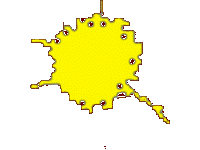  
Got something to say about this article? Want to agree (or
disagree) with it? Click the following link to go to the GUNBlast Feedback Page.
All content © 2004 GunBlast.com.
All rights reserved. |
|
Click pictures for a larger version.
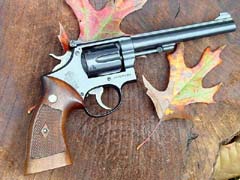
This is the K-22 often referenced as
the “Pre Model 17” It
was produced in 1947. The sights are
the 1/10th inch option discontinued in 1952.
The barrel and Ejector rod are of Pre-War Origin.
Also in 1947: India achieved
independence from Great Britain.
Three hundred Hollywood Actors,
directors and other motion picture employees were blacklisted
because of known or suspected affiliation with the Communist
Party.
John Steinbeck published “ The
Wayward Bus”
Chuck Yeager flew an Experimental Bell
Rocket Plane to Mach 1.06 becoming the first man to break the
Sound Barrier.
Harry S Truman was President of the
United States
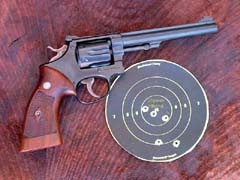
Hamilton Bowen shot this K-22 and
commented. “She’s an accurate old girl”
Quite a recommendation from history's premier Custom
Revolver Smith.
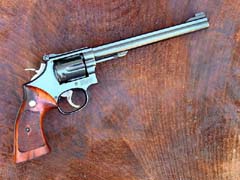
The last of the K-22 / Model 17s. Shooters deplored the change in barrel threading that
eliminated the traditional retaining pin.
The 8 3/8” barrel was introduced in 1958. Other
features include the desirable Target Sights, Target Trigger
and Target Hammer.
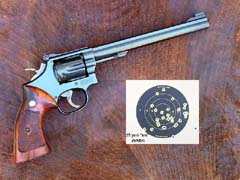
Thirty rounds Off-hand Slow-fire.
Trigger finger placement is made less critical by the wide
grooved Target Trigger - a straight back, undisturbed,
repeatable trigger release is relatively easy to obtain.
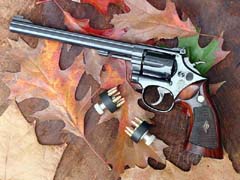
The long 17 is a prime small game
revolver. It is
very accurate with several high velocity hollow point loads.
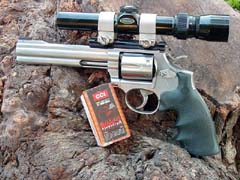
The weaver 1.5-3 LER Scope is useful
for load testing and field use.
Optics are a big aid to shooters with poor vision and
are particularly useful for hunting in poor light.
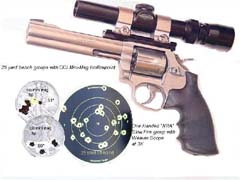
The Scoped 617 weighs 62 ounces. The NRA center was shot one handed. The small groups are from the bench at 25 yards with CCI
Mini-Mag Hollow Points.
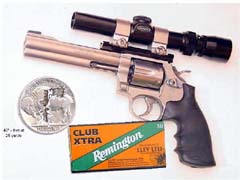
The Eley Cub match produced the
smallest group from this revolver to date.
It also shot one of the largest at 1.4”
. Several
High Velocity and Hyper Velocity hollow points actually turned
in better multiple group averages.
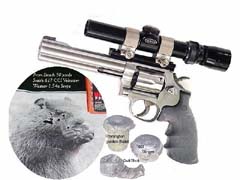
Stingers and Velocitors turn in
varmint killing accuracy at 50 yards.
The Remington Golden bullets were the slowest tested
clocking high 900s to low 1,000 fps range in the three
revolvers but consistently expanded when shot into a beef
brisket at 50 yards. Stingers
expanded with fragmentation and vaporize when shot into media
at 25 yards. The
QuikShok rounds are designed to break into three major pieces
and create huge wound channels on small varmints.
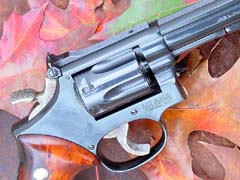
THTT was all the rage from the late
.60s up until about 1990 when double action shooters decided a
smooth trigger was better.
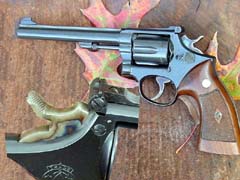
The early post-War K22 had a narrow
grooved trigger and a hand checkered hammer with graceful
sweep. The narrow
trigger requires critical placement of the finger for good
control but once this is learned the old gun is extremely
accurate.
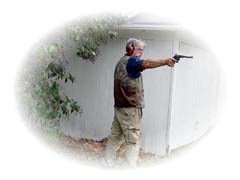
The model 17 is forgiving of shooting
errors. A range session with this is a good way to find out if
you still know how to shoot.
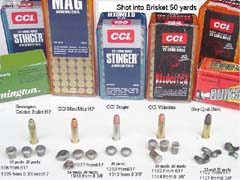
With the Rimfires, barrel length is
not always a reliable predictor of velocity. |
![]()